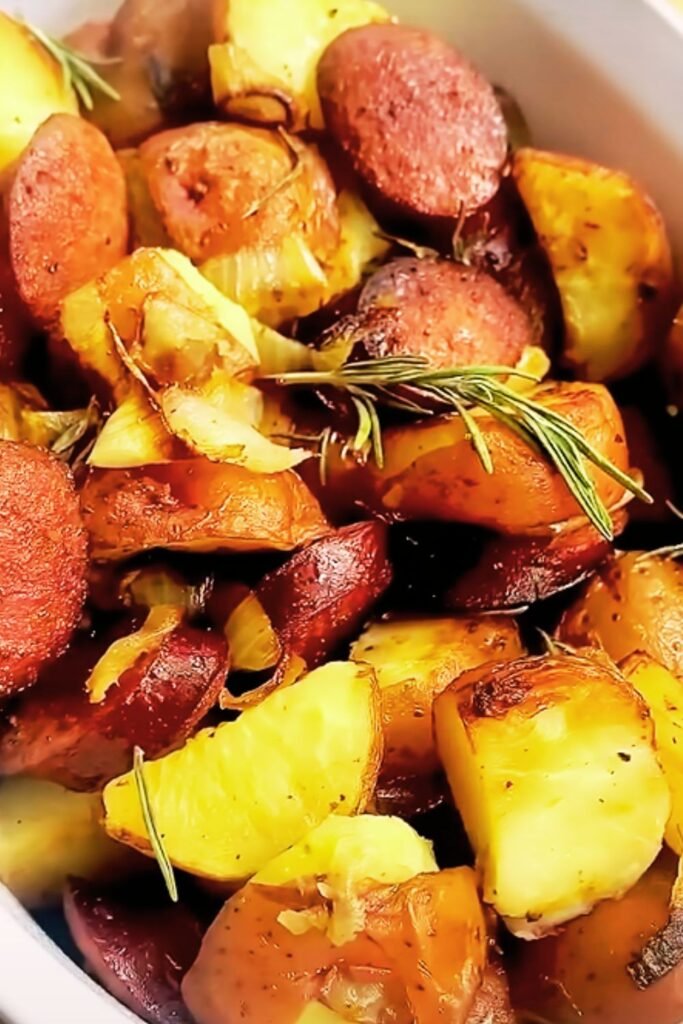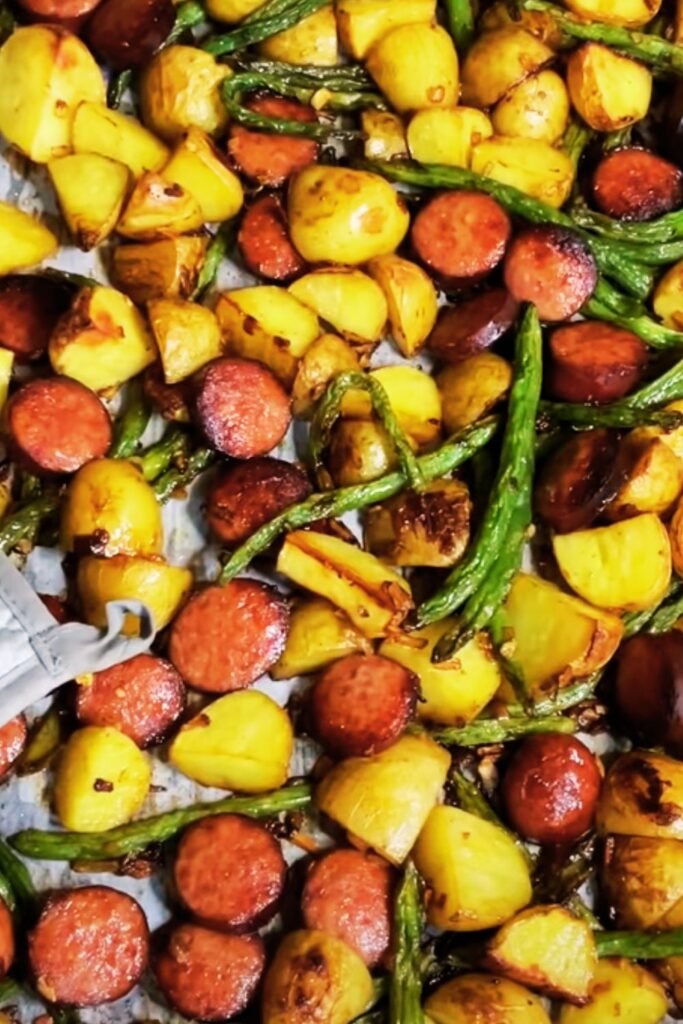There’s something magical about the combination of smoky sausage and tender potatoes that speaks directly to my soul. I’ve been perfecting this recipe for years, and I can confidently say it’s become my go-to dish when I need something hearty, satisfying, and incredibly delicious. Whether you’re feeding a hungry family on a weeknight or looking for a crowd-pleasing dish for your next gathering, smoked sausage and potatoes delivers every single time.
This isn’t just another recipe – it’s a complete guide that’ll transform how you think about this classic combination. I’ve discovered countless variations, cooking methods, and secret tips that’ll make your version stand out from the rest. From selecting the perfect sausage to achieving that ideal potato texture, I’m sharing everything I’ve learned through years of cooking and experimenting.
Understanding the Foundation: Key Ingredients
Smoked Sausage Types
Kielbasa: Traditional Polish sausage with a robust, garlicky flavor that pairs beautifully with potatoes Andouille: Cajun-style sausage bringing heat and complex spicing to the dish Bratwurst: German sausage offering a milder, herb-forward taste profile Turkey Sausage: Lighter option that doesn’t compromise on flavor while reducing fat content Chorizo: Spanish or Mexican varieties adding paprika warmth and distinctive smokiness
Potato Varieties and Their Impact
Russet Potatoes: High starch content creates fluffy interiors when roasted properly Red Potatoes: Waxy texture holds shape well during cooking, perfect for skillet preparations Yukon Gold: Creamy texture and buttery flavor enhance the overall dish complexity Fingerling Potatoes: Unique shapes and concentrated flavors add visual appeal and taste variety Sweet Potatoes: Natural sweetness balances the savory sausage elements beautifully
The Science Behind Perfect Smoked Sausage and Potatoes
Understanding the cooking science has revolutionized my approach to this dish. When I properly brown the sausage first, I create fond – those beautiful caramelized bits that become the flavor foundation. The Maillard reaction occurring during this process develops complex flavors that simple boiling or steaming cannot achieve.
Potatoes require different treatment depending on their starch content. High-starch varieties like Russets need higher temperatures to develop crispy exteriors while maintaining fluffy centers. Waxy potatoes benefit from gentler cooking methods that preserve their structure while allowing flavors to penetrate.
My Foolproof One-Pan Method
This technique has become my signature approach because it maximizes flavor while minimizing cleanup. I start by heating my largest cast-iron skillet over medium-high heat, then add sliced sausage without any oil. The sausage releases its own fat, which becomes the cooking medium for everything else.

Once the sausage develops beautiful caramelization, I remove it temporarily and add cubed potatoes to the same pan. This allows the potatoes to absorb those incredible flavors while developing their own golden crust. The key is patience – rushing this step results in unevenly cooked potatoes.
Step-by-Step One-Pan Instructions
- Prepare ingredients: Cut sausage into ½-inch rounds, cube potatoes uniformly
- Brown sausage: Cook 3-4 minutes per side until deeply golden
- Remove sausage: Set aside while maintaining rendered fat in pan
- Cook potatoes: Add to hot fat, season generously with salt and pepper
- Develop crust: Allow 5-6 minutes without stirring for proper browning
- Add aromatics: Include onions, garlic, and herbs during final cooking stages
- Combine elements: Return sausage to pan, toss everything together
- Finish cooking: Continue until potatoes reach desired tenderness
Oven-Roasted Perfection
My oven method produces incredibly consistent results with minimal hands-on time. I preheat my oven to 425°F and use a large rimmed baking sheet lined with parchment paper. This temperature strikes the perfect balance between browning and cooking through.
The secret lies in proper spacing – overcrowding leads to steaming rather than roasting. I arrange everything in a single layer, ensuring each piece has breathing room. Halfway through cooking, I give everything a good stir to promote even browning.
Oven-Roasted Timeline
| Time | Temperature | Action |
|---|---|---|
| 0 minutes | 425°F | Preheat oven, prepare ingredients |
| 5 minutes | 425°F | Toss sausage and potatoes with oil and seasonings |
| 10 minutes | 425°F | Spread on baking sheet, place in oven |
| 25 minutes | 425°F | Stir ingredients, redistribute evenly |
| 40-45 minutes | 425°F | Check for doneness, golden browning |
Slow Cooker Magic for Busy Days
My slow cooker version has saved countless weeknight dinners. I layer sliced potatoes in the bottom, add sausage rounds, then cover with sliced onions and seasonings. The beauty of this method is its complete hands-off nature – perfect for busy schedules.
I’ve learned that adding liquid isn’t necessary since the ingredients release their own moisture during cooking. Too much liquid results in mushy potatoes, which nobody wants. A light coating of oil and proper seasoning are all that’s needed.

Flavor Enhancement Strategies
Seasoning Combinations That Work
Mediterranean Blend: Oregano, thyme, rosemary, and garlic powder Cajun Spice: Paprika, cayenne, garlic powder, and onion powder German-Inspired: Caraway seeds, dill, and black pepper Italian Herbs: Basil, oregano, garlic, and red pepper flakes Smoky BBQ: Smoked paprika, brown sugar, and chipotle powder
Vegetable Additions
I’ve discovered that certain vegetables complement this dish beautifully without overwhelming the core flavors. Bell peppers add sweetness and crunch, while onions provide aromatic depth. Mushrooms contribute earthiness, and zucchini offers freshness during summer months.
The timing of vegetable additions matters significantly. Hardy vegetables like carrots and Brussels sprouts need longer cooking times, while delicate options like spinach should be added during the final minutes.
Nutritional Breakdown and Health Considerations
| Nutrient | Per Serving (6 servings) | Daily Value % |
|---|---|---|
| Calories | 420 | 21% |
| Protein | 18g | 36% |
| Carbohydrates | 32g | 11% |
| Fat | 24g | 37% |
| Fiber | 4g | 16% |
| Sodium | 890mg | 39% |
| Potassium | 720mg | 15% |
| Iron | 2.1mg | 12% |
I’ve found ways to make this dish healthier without sacrificing flavor. Using turkey sausage reduces fat content significantly while maintaining protein levels. Adding extra vegetables increases fiber and vitamins. Controlling portion sizes and serving with a fresh salad creates a more balanced meal.
Storage and Reheating Guidelines
Proper storage extends the life of this dish considerably. I cool leftovers completely before refrigerating in airtight containers. The dish keeps well for up to four days, though the potatoes may soften slightly over time.
For reheating, I prefer using the oven rather than the microwave. Spreading leftovers on a baking sheet and heating at 350°F for 10-15 minutes restores some of the original texture. Adding a splash of broth or water prevents drying out.
Storage Timeline
| Storage Method | Duration | Quality Notes |
|---|---|---|
| Refrigerator | 3-4 days | Best texture within 2 days |
| Freezer | 2-3 months | Potatoes may become slightly grainy |
| Room Temperature | 2 hours maximum | Food safety considerations |
Serving Suggestions and Pairings
This dish shines as a complete meal, but I love pairing it with complementary sides. A crisp green salad with vinaigrette cuts through the richness beautifully. Steamed broccoli or green beans add color and nutrition. Crusty bread helps soak up any delicious pan juices.
For breakfast or brunch serving, I top individual portions with fried or poached eggs. The runny yolk creates an incredible sauce that ties everything together. Fresh herbs like chives or parsley brighten the overall presentation.

Troubleshooting Common Issues
Problem: Mushy Potatoes
Solution: Use waxy potato varieties, avoid overcooking, maintain proper temperature
Problem: Uneven Browning
Solution: Ensure single-layer cooking, preheat pan properly, avoid overcrowding
Problem: Dry Sausage
Solution: Don’t overcook, choose quality sausages with adequate fat content
Problem: Bland Flavor
Solution: Season generously, brown ingredients properly, use aromatic vegetables
Seasonal Variations I Love
Spring Version: Add asparagus, fresh peas, and lemon zest during final cooking minutes Summer Adaptation: Include zucchini, corn kernels, and fresh basil for brightness Fall Comfort: Incorporate butternut squash, sage, and caramelized onions Winter Warmth: Add root vegetables, rosemary, and hearty greens like kale
Each seasonal variation maintains the core concept while celebrating ingredients at their peak. I adjust cooking times based on the additional vegetables’ requirements, ensuring everything finishes simultaneously.
Advanced Techniques for Flavor Development
Deglazing Method
After browning sausage and potatoes, I sometimes deglaze the pan with white wine, chicken broth, or even apple cider. This technique incorporates those flavorful brown bits directly into the dish while adding complexity.
Herb Oil Finishing
I prepare herb-infused oil by gently warming olive oil with fresh herbs like thyme, rosemary, or sage. Drizzling this over the finished dish adds aromatic intensity and visual appeal.
Cheese Integration
While not traditional, I occasionally fold in sharp cheddar or Parmesan during the final minutes. The cheese melts partially, creating pockets of creamy richness throughout the dish.
Equipment Recommendations
Essential Tools
Large Cast-Iron Skillet: Superior heat retention and browning capabilities Rimmed Baking Sheet: Even heat distribution for oven methods Sharp Chef’s Knife: Clean cuts prevent cell damage and moisture loss Wooden Spoon: Gentle stirring that won’t damage potato surfaces
Nice-to-Have Items
Mandoline Slicer: Uniform potato cuts for even cooking Instant-Read Thermometer: Ensures proper internal temperatures Fine-Mesh Strainer: Removes excess starch from cut potatoes
Questions and Answers
Q: Can I prepare this dish ahead of time? I recommend preparing components separately if making ahead. Cut potatoes and store in cold water, pre-slice sausage, and prepare seasonings. Combine and cook when ready to serve for best results.
Q: Which sausage variety works best for beginners? Kielbasa offers the most foolproof results due to its balanced flavor and reliable cooking characteristics. It’s widely available and pairs well with most potato varieties.
Q: How do I prevent potatoes from sticking to the pan? Ensure your pan is properly preheated and use adequate fat. Don’t move potatoes too early – they’ll release naturally once properly browned.
Q: Can I make this dish vegetarian? Absolutely! Replace sausage with hearty vegetables like mushrooms, eggplant, or plant-based sausage alternatives. Adjust seasonings to compensate for reduced smokiness.
Q: What’s the best way to cut potatoes for even cooking? Aim for uniform ¾-inch pieces. Consistent sizing ensures everything cooks at the same rate, preventing some pieces from burning while others remain undercooked.
Q: How do I know when the dish is properly cooked? Potatoes should be tender when pierced with a fork, and sausage should reach an internal temperature of 165°F. Visual cues include golden-brown coloring on most surfaces.
Q: Can I double this recipe for larger groups? Yes, but use two pans or cook in batches. Overcrowding prevents proper browning and leads to steaming instead of searing.
Q: What should I do if my sausage seems too salty? Balance excess saltiness by adding acidic elements like lemon juice or vinegar. You can also increase the potato quantity to dilute the overall sodium content.
Q: How do I reheat leftovers without losing texture? Oven reheating at 350°F works best. Spread leftovers on a baking sheet, add a splash of broth, and cover with foil for the first 10 minutes.
Q: Can I freeze this dish? While possible, frozen potatoes become grainy upon thawing. If freezing is necessary, slightly undercook the potatoes initially and expect some texture changes.
This hearty combination of smoked sausage and potatoes has earned its place as a beloved comfort food for good reason. The flexibility in preparation methods, endless variation possibilities, and consistent crowd-pleasing results make it an invaluable addition to any cook’s repertoire. Whether you choose the quick one-pan method, the hands-off oven approach, or the convenient slow cooker technique, you’ll create a satisfying meal that brings people together around the table.